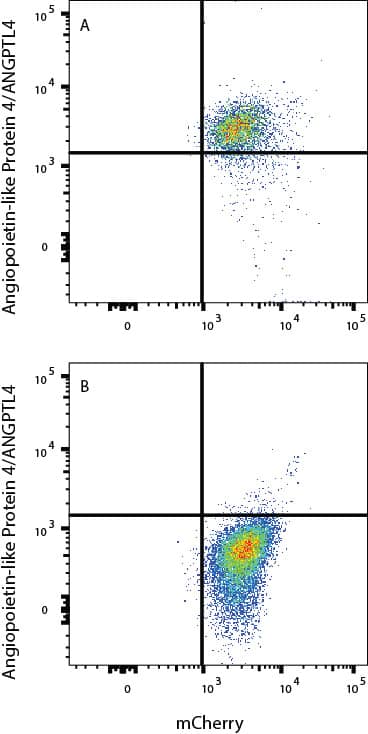Human Angiopoietin-like Protein 4/ANGPTL4 Antibody
R&D Systems, part of Bio-Techne | Catalog # MAB11305


Conjugate
Catalog #
Key Product Details
Species Reactivity
Human
Applications
Flow Cytometry
Label
Unconjugated
Antibody Source
Monoclonal Mouse IgG2B Clone # 944740
Product Specifications
Immunogen
Mouse myeloma cell line, NS0-derived human Angiopoietin-like Protein 4/ANGPTL4 protein
Gly26-Ser406
Accession # Q9BY76
Gly26-Ser406
Accession # Q9BY76
Specificity
Detects human Angiopoietin‑like Protein 4/ANGPTL4 Antibody in direct ELISA.
Clonality
Monoclonal
Host
Mouse
Isotype
IgG2B
Scientific Data Images for Human Angiopoietin-like Protein 4/ANGPTL4 Antibody
Detection of Angiopoietin-like Protein 4/ANGPTL4 in CHO cells by Flow Cytometry.
CHO cells transfected with hANGPTL4 and mCherry (A) vs irrelevant cells (B) were stained with mCherry and Mouse Anti-Human Angiopoietin-like Protein 4/ANGPTL4 Monoclonal Antibody (Catalog # MAB11305). View our protocol for Staining Membrane-associated Proteins.Applications for Human Angiopoietin-like Protein 4/ANGPTL4 Antibody
Application
Recommended Usage
Flow Cytometry
0.25 µg/106 cells
Sample: CHO cells transfected with hANGPTL4 and mCherry vs irrelevant cells
Sample: CHO cells transfected with hANGPTL4 and mCherry vs irrelevant cells
Formulation, Preparation, and Storage
Purification
Protein A or G purified
Reconstitution
Reconstitute at 0.5 mg/mL in sterile PBS. For liquid material, refer to CoA for concentration.
Formulation
Lyophilized from a 0.2 μm filtered solution in PBS with Trehalose. See Certificate of Analysis for details.
*Small pack size (-SP) is supplied either lyophilized or as a 0.2 μm filtered solution in PBS. *Small pack size (SP) is supplied either lyophilized or as a 0.2 µm filtered solution in PBS.
*Small pack size (-SP) is supplied either lyophilized or as a 0.2 μm filtered solution in PBS. *Small pack size (SP) is supplied either lyophilized or as a 0.2 µm filtered solution in PBS.
Shipping
Lyophilized product is shipped at ambient temperature. Liquid small pack size (-SP) is shipped with polar packs. Upon receipt, store immediately at the temperature recommended below.
Stability & Storage
Use a manual defrost freezer and avoid repeated freeze-thaw cycles.
- 12 months from date of receipt, -20 to -70 °C as supplied.
- 1 month, 2 to 8 °C under sterile conditions after reconstitution.
- 6 months, -20 to -70 °C under sterile conditions after reconstitution.
Background: Angiopoietin-like Protein 4/ANGPTL4
References
- Zhu, P. et al. (2012) Biosci. Rep. 32:211.
- Ge, H. et al. (2004) J. Biol. Chem. 279:2038.
- Sukonina, V. et al. (2006) Proc. Natl. Acad. Sci. USA 103:17450.
- Mandard, S. et al. (2006) J. Biol. Chem. 281:934.
- Xu, A. et al. (2005) Proc. Natl. Acad. Sci. USA 102:6086.
- Kersten, S. et al. (2000) J. Biol. Chem. 275:28488.
- Cazes, A. et al. (2006) Circ. Res. 99:1207.
- Le Jan, S. et al. (2003) Am. J. Pathol. 162:1521.
- Goh, Y.Y. et al. (2010) Am. J. Pathol. 177:2791.
- Goh, Y.Y. et al. (2010) J. Biol. Chem. 285:32999.
- Blank, U. et al. (2012) Eur. J. Haematol. 89:198.
- Hou, M. et al. (2014) PLoS ONE 9:e85808.
- Clement, L.C. et al. (2011) Nat. Med. 17:117.
Alternate Names
Angiopoietin like Protein 4, ANGPTL4, FIAF, HFARP, PGAR
Gene Symbol
ANGPTL4
UniProt
Additional Angiopoietin-like Protein 4/ANGPTL4 Products
- All Products for Angiopoietin-like Protein 4/ANGPTL4
- Angiopoietin-like Protein 4/ANGPTL4 cDNA Clones
- Angiopoietin-like Protein 4/ANGPTL4 ELISA Kits
- Angiopoietin-like Protein 4/ANGPTL4 Lysates
- Angiopoietin-like Protein 4/ANGPTL4 Primary Antibodies
- Angiopoietin-like Protein 4/ANGPTL4 Proteins and Enzymes
- Angiopoietin-like Protein 4/ANGPTL4 Simple Plex
Product Documents for Human Angiopoietin-like Protein 4/ANGPTL4 Antibody
Product Specific Notices for Human Angiopoietin-like Protein 4/ANGPTL4 Antibody
For research use only
